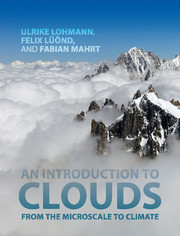Book contents
- Frontmatter
- Dedication
- Contents
- Preface
- List of symbols and acronyms
- 1 Clouds
- 2 Thermodynamics
- 3 Atmospheric dynamics
- 4 Mixing and convection
- 5 Atmospheric aerosol particles
- 6 Cloud droplet formation and Köhler theory
- 7 Microphysical processes in warm clouds
- 8 Microphysical processes in cold clouds
- 9 Precipitation
- 10 Storms and cloud dynamics
- 11 Global energy budget
- 12 Impact of aerosol particles and clouds on climate
- References
- Index
8 - Microphysical processes in cold clouds
Published online by Cambridge University Press: 05 June 2016
- Frontmatter
- Dedication
- Contents
- Preface
- List of symbols and acronyms
- 1 Clouds
- 2 Thermodynamics
- 3 Atmospheric dynamics
- 4 Mixing and convection
- 5 Atmospheric aerosol particles
- 6 Cloud droplet formation and Köhler theory
- 7 Microphysical processes in warm clouds
- 8 Microphysical processes in cold clouds
- 9 Precipitation
- 10 Storms and cloud dynamics
- 11 Global energy budget
- 12 Impact of aerosol particles and clouds on climate
- References
- Index
Summary
As discussed in Chapter 7, warm rain formation is not sufficient to explain most global precipitation. Globally 50% of all precipitation events of more than 1 mm d-1 involve the formation and growth of ice crystals somewhere in the cloud (Field and Heymsfield, 2015). In the tropics, precipitation via the ice phase accounts for 69% of the total precipitation (Lau and Wu, 2003). In mid-latitudes, warm rain is even less prevalent, especially over land. Here it accounts for less than 10% of the total precipitation because of the smaller cloud droplets in continental clouds as compared with marine clouds (Mülmenstädt et al., 2015).
Once a cloud extends to altitudes where the temperature is below 0°C, ice crystals may form by the homogeneous freezing of cloud droplets or by the heterogeneous ice nucleation, as discussed below in Section 8.1. Heterogeneous ice nucleation takes place with the help of ice nucleating particles (INPs) and can occur via different pathways depending on the temperature and supersaturation (Section 8.1.2).
Once nucleated, the ice crystals can grow by diffusion from the vapor phase (Section 8.3). As long as they keep their identity, they are called pristine crystals. They can also grow by aggregation to form snowflakes or by riming to form graupel and hail. The counterpart of raindrop break-up is ice multiplication, which also occurs upon collision and drastically enhances the number concentration of ice crystals in the cloud. The melting of ice and snow and the sublimation of snow (Section 8.4.2) complete our discussion of these microphysical processes; a summary is given in Section 8.5.
Ice nucleation
As discussed in Section 6.1, nucleation denotes a phase transition where a cluster of a thermodynamically stable phase forms and grows within the surrounding metastable parent phase. Ice crystals can form by the direct deposition of water vapor on an INP (deposition nucleation) or by the freezing of a cloud droplet or solution droplet (Section 6.4). The term solution droplet refers to a liquid aerosol, such as sulfuric acid or sodium chloride, that has undergone hygroscopic growth (Section 6.3). A cloud droplet, however, is sufficiently large that the amount of solute is negligible and it can be regarded as a pure water droplet.
- Type
- Chapter
- Information
- An Introduction to CloudsFrom the Microscale to Climate, pp. 218 - 250Publisher: Cambridge University PressPrint publication year: 2016
- 1
- Cited by



